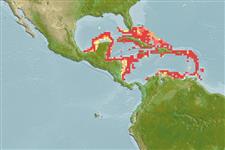>
Ophidiiformes (Cusk eels) >
Ophidiidae (Cusk-eels) > Ophidiinae
Etymology: Lepophidium: Latin, lepus, leporis = rabbit + Greek, ophis = serpent (Ref. 45335); wileyi: Named for Edward O. Wiley.
Eponymy: Dr Edward Orlando Wiley III (d: 1944) is a biologist who is Professor of Systematics and Evolutionary Biology and Curator Emeritus, Ichthyology, Natural History Museum, University of Kansas. [...] (Ref. 128868), visit book page.
Environment: milieu / climate zone / depth range / distribution range
Ecologia
marinhas bentopelágico; intervalo de profundidade 60 - 402 m (Ref. 91765), usually 200 - 300 m (Ref. 91765). Tropical; 26°N - 10°N, 95°W - 59°W (Ref. 91765)
Western Atlanic Ocean: from the western edge of the Bahamas and Cuba along the Antillean chain to Trinidad and in the southern, eastern, and western Caribbean Sea; a collection is known from the Gulf of Mexico northwest of the Yucatan Peninsula.
Tamanho / Peso / Idade
Maturity: Lm ? range ? - ? cm
Max length : 20.9 cm SL macho/indeterminado; (Ref. 91765)
Descrição suscinta
Chaves de identificação | Morfologia | Morfometria
Raios dorsais (total) : 124 - 135; Raios anais : 105 - 117; Vértebras: 70 - 75. This species is characterized by the following: fringed snout; average snout length 20.9% in HL; average bony interorbit distance 18.6% in HL; average lateral line length 91.5% in SL; average post orbital head length 20.7% in HL; average preanal distance 36.7% in SL; head and body color tan and without pattern; no white spot on symphyseal region of the snout (Ref. 91765).
Ciclo de vida ou comportamento de acasalamento
Maturidade | Reprodução | Desova | Ovos | Fecundidade | Larvas
Robins, C.R., R.H. Robins and M.E. Brown, 2012. A revision of Lepophidium (Teleoastei, Ophidiidae), with descriptions of eight new species. Bulletin of the Florida Museum of Natural History 52(1):1-94. (Ref. 91765)
Status na Lista Vermelha da UICN (Ref. 130435: Version 2024-2)
Ameaça para os humanos
Harmless
Uso pelos humanos
Ferramentas
Relatórios especiais
Baixar XML
Fontes da internet
Estimates based on models
Preferred temperature (Ref.
123201): 14.1 - 22, mean 18.4 °C (based on 35 cells).
Índice de diversidade filogenética (Ref.
82804): PD
50 = 0.5000 [Uniqueness, from 0.5 = low to 2.0 = high].
Bayesian length-weight: a=0.00102 (0.00046 - 0.00225), b=3.06 (2.88 - 3.24), in cm total length, based on all LWR estimates for this body shape (Ref.
93245).
Nível Trófico (Ref.
69278): 3.6 ±0.7 se; based on size and trophs of closest relatives
Resiliência (Ref.
120179): Elevada, tempo mínimo de duplicação da população menor que 15 meses (Preliminary K or Fecundity.).
Fishing Vulnerability (Ref.
59153): Low vulnerability (16 of 100).
